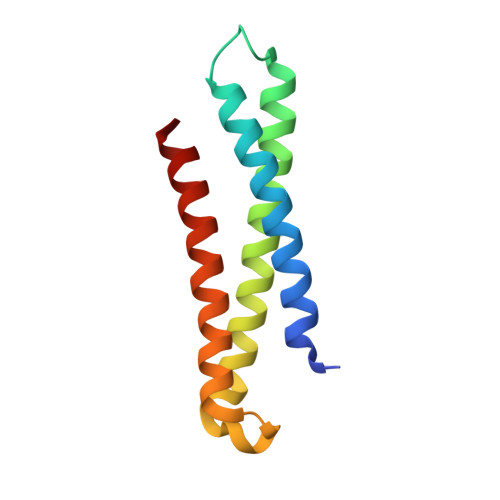Three-dimensional structure of the amino-terminal domain of syntaxin 6, a SNAP-25 C homolog.
Misura, K.M., Bock, J.B., Gonzalez Jr., L.C., Scheller, R.H., Weis, W.I.(2002) Proc Natl Acad Sci U S A 99: 9184-9189
- PubMed: 12082176
- DOI: https://doi.org/10.1073/pnas.132274599
- Primary Citation of Related Structures:
1LVF - PubMed Abstract:
Soluble N-ethylmaleimide-sensitive factor attachment protein receptor (SNARE) proteins are required for intracellular membrane fusion, and are differentially localized throughout the cell. SNAREs on vesicle and target membranes contain "SNARE motifs" which interact to form a four-helix bundle that contributes to the fusion of two membranes. SNARE motif sequences fall into four classes, homologous to the neuronal proteins syntaxin 1a, VAMP 2, and the N- and C-terminal SNARE motifs of SNAP-25 (S25N and S25C), and it is thought that one member from each class interacts to form a SNARE complex. Many SNAREs also feature N-terminal domains believed to function in regulating SNARE complex assembly or other aspects of vesicle transport. Syntaxin 6 is a SNARE found primarily in endosomal transport vesicles and whose SNARE motif shows significant homology to both syntaxin 1a and S25C. The crystal structure of the syntaxin 6 N-terminal domain reveals strong structural similarity with the N-terminal domains of syntaxin family members syntaxin 1a, Sso1p, and Vam3p, despite a very low level of sequence similarity. The syntaxin 6 SNARE motif can substitute for S25C in in vitro binding experiments, supporting the classification of syntaxin 6 as an S25C family member. Secondary structure prediction of SNARE proteins shows that the N-terminal domains of many syntaxin, S25N, and S25C family members are likely to be similar to one another, but are distinct from those of VAMP family members, indicating that syntaxin, S25N, and S25C SNAREs may have shared a common ancestor.
- Departments of Structural Biology and Molecular and Cellular Physiology, Stanford University School of Medicine, Stanford, CA 94305.
Organizational Affiliation:
















